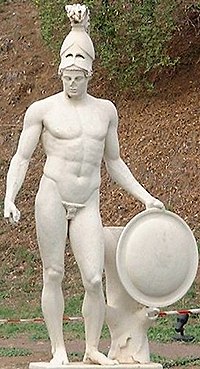This is an old revision of this page, as edited by Paul August (talk | contribs) at 03:07, 18 December 2006 (Reverted edits by Sd31415 (talk) to last version by Watchsmart). The present address (URL) is a permanent link to this revision, which may differ significantly from the current revision.
Revision as of 03:07, 18 December 2006 by Paul August (talk | contribs) (Reverted edits by Sd31415 (talk) to last version by Watchsmart)(diff) ← Previous revision | Latest revision (diff) | Newer revision → (diff) For other uses, see Ares (disambiguation).| Greek deities series | |||||
|---|---|---|---|---|---|
| |||||
In Greek mythology, Ares (in Greek, Άρης — "battle strife") is the son of Zeus (king of the gods) and Hera. Though often incorrectly referred to as the Olympian god of war, he is more accurately the god of savage war, or bloodlust. The Romans identified him as Mars, the Roman god of war (whom they had inherited from the Etruscans) with Hellenic Ares, but among them, Mars stood in much higher esteem.
Among the Hellenes, Ares was always mistrusted. His birthplace and true home was placed far off, among the barbarous and warlike Thracians (Iliad 13.301; Ovid). And he withdrew to Thrace after he was discovered on a couch with Aphrodite (Odyssey 8.361). Though Ares' half-sister Athena was also considered to be a war deity, Athena's stance was that of strategic warfare while Ares' tended to be the unpredictable violence of war with all its potential outcomes.
"Ares" remained an adjective and epithet in Classical times: Zeus Areios, Athena Areia, even Aphrodite Areia. In Mycenaean times, inscriptions attest to Enyalios, a name that survived into Classical times as an epithet of Ares. Vulture and dog are sacred to him.
Ares' symbols


Ares had a quadriga drawn by four gold-bridled (Iliad v.352) fire-breathing immortal stallions. Among the gods, Ares was recognized by his brazen armour; he brandished a spear in battle. His sacred birds were the barn owl, woodpecker and especially the vulture. According to Argonautica (ii.382ff and 1031ff; Hyginus, Fabulae 30) the birds of Ares (Ornithes Areioi) were a flock of feather-dart-dropping birds that guarded the Amazons' shrine of the god on a coastal island in the Black sea. In Sparta the chthonic night-time sacrifice of a puppy to Enyalios became assimilated to the cult of Ares.
In classical Greek art his usual attributes were a crested helm and spear.
Ares in cult
Although important in poetry, Ares was rarely included in cult in ancient Greece, save at Sparta, where he was propitiated before battle. And though involved in the founding myth of Thebes, he appeared in few myths (Burkert 1985, p.169).
At Sparta there was a statue of the god in chains, to show that the spirit of war and victory was never to leave the city; dogs (and some believe even humans) were sacrificed to him. The temple to Ares in the agora of Athens that Pausanias saw in the second century AD had only been moved and rededicated there during the time of Augustus; in essence it was a Roman temple to Mars. The Areopagus, the "hill of Ares" where Paul of Tarsus preached, is sited at some distance from the Acropolis; from archaic times it was a site of trials. Its connection with Ares, perhaps based on a false etymology, may be purely etiological.
Attendants
Deimos and Phobos were his children by Aphrodite and were the spirit of terror and fear. The sister and companion of murderous Ares was Enyo, goddess of bloodshed and violence. The presence of Ares was accompanied by Kydoimos, the daemon of the din of battle, as well as the Makhai (Battles), the Hysminai (Manslaughters), Polemos (a minor spirit of war; probably an epithet of Ares, as he had no specific dominion), and Polemos' daughter, Alala, goddess/personification of the Greek war-cry, whose name Ares used as his own war-cry.
The founding of Thebes
One of the many roles of Ares that was sited in mainland Greece itself was in the founding myth of Thebes: Ares was the progenitor of the water-dragon slain by Cadmus, and hence the ancestor of the Spartans (the dragon's teeth were sown into the ground, and sprung up as the fully armored autochthonic Spartans). From the dragon's teeth sown as if a crop arose a race of fighting men, the descendents of Ares. To propitiate Ares, Cadmus took as a bride Harmonia, daughter of Ares' union with Aphrodite, thus harmonizing all strife and founding the city of Thebes.
Consorts and Children
There are accounts of a son of Ares, Cycnus (Kýknos) of Macedonia, who was so murderous that he attempted to build a temple with the skulls and the bones of travellers. Heracles slaughtered this abominable monstrosity, engendering the wrath of Ares, whom the hero wounded (Apollodorus 2.114).
Other consorts and children of Ares include:
- Aglaulus
- Aphrodite
- Cyrene
- Harpina (or Sterope, according to some accounts)
- Otrera
- Pyrene
- Astyoche
- Ascalaphus and Ialmenus
- Bistonis
- Rhea Silvia (Roman mythology)
- Unknown mothers
Ares in the myths
Ares and Aphrodite
In the myth sung by the bard in the hall of Alcinous (Odyssey viii.300ff) the Sun-God, Helios, once spied Ares and Aphrodite enjoying each other secretly in the hall of Hephaestus and how he promptly reported the incident to Aphrodite's Olympian consort. Hephaestus contrived to catch the couple in the act, and so he fashioned a net with which to snare the illicit lovers. At the appropriate time, this net was sprung, and trapped Ares and Aphrodite locked in very private embrace. But Hephaestus was not yet satisfied with his revenge - he invited the Olympian gods and goddesses to view the unfortunate pair. For the sake of modesty, the goddesses demurred, but the male gods went to witness the sight. Some commented on the beauty of Aphrodite, others remarked that they would eagerly trade places with Ares, but all mocked the two. Once the couple were loosed, Ares, embarrassed, sped away to his homeland, Thrace. (In a much later interpolated detail, Ares put the youth Alectryon by his door to warn them of Helios' arrival, as Helios would tell Hephaestus of Aphrodite's infidelity if the two were discovered, but Alectryon fell asleep. Helios discovered the two and alerted Hephaestus. Ares was furious and turned Alectryon into a rooster, which now never forgets to announce the arrival of the sun in the morning.)
Ares and the giants
In one archaic myth, related in the Iliad by the goddess Dione to her daughter Aphrodite, two chthonic giants, the Aloadae, Otus and Ephialtes, threw Ares into chains and put him in a bronze urn, where he remained for thirteen months, a lunar year. "And that would have been the end of Ares and his appetite for war, if the beautiful Eriboea, the young giants' stepmother, had not told Hermes what they had done," she related (Iliad 5.385–391). "In this one suspects a festival of licence which is unleashed in the thirteenth month." Ares remained screaming and howling in the urn until Hermes rescued him and Artemis tricked the Aloadae into slaying each other.
The Iliad
In the Iliad, Homer represented Ares as having no fixed allegiances nor respect for Themis, the right ordering of things: he promised Athena and Hera that he would fight on the side of the Achaeans, but Aphrodite was able to persuade Ares to side with the Trojans. During the war, Diomedes fought with Hector and saw Ares fighting on the Trojans' side. Diomedes called for his soldiers to fall back slowly. Hera, Ares's mother, saw his interference and asked Zeus, his father, for permission to drive Ares away from the battlefield. Hera encouraged Diomedes to attack Ares, so he threw a spear at Ares. Athena then drove the spear into Ares's body, who bellowed in pain and fled to Mt. Olympus, forcing the Trojans to fall back. Later when Zeus allows the gods to fight in the war again, Ares tries to fight Athena to avenge himself for his previous injury, but is once again badly injured when she tosses a huge boulder on him.
Ares in the Renaissance
In Renaissance and Neoclassical works of art, Ares' symbols are a spear and helmet, his animal is the dog, and his bird is the vulture. In literary works of these eras, Ares appears as cruel, aggressive, and blood-thirsty, reviled by both gods and humans, much as he was in the ancient Greek myths.
References
- Robert Graves, The Greek Myths rev. ed. 1960. 19:"Ares natures and deeds" et passim
- Karl Kerenyi, The Gods of the Greeks 1951.
- Walter Burkert, Greek Religion 1958 2.12 et passim
- Burkert, Walter, 1985. Greek Religion (Cambridge: Harvard University Press)
- Kerenyi, Carl, 1951. Gods of the Greeks (London:Thames & Hudson)
Ares In Pop Culture
- Ares is the villainous antagonist in the 2005 video game, God of War.
- Ares is an enemy of Wonder Woman in DC Comics.
- Ares (Marvel Comics) is another of the many allies/minions Hades has in Marvel Comics. He was supposed to marry his former lover Aphrodite under Hades' wishes until the conspiracy was discovered.
- Ares is a Korean Manga about a group of mercenaries.
- In the Soul Calibur series, Ares serves as Astaroth's master.
- Ares appears in the game Zeus Master of Olympus.
- Ares was portrayed by kiwi actor Kevin Smith in the series Xena: Warrior Princess
Notes
- The reading often remains ambiguous, as in a late sixth-century funerary inscription from Attica: "Stay and mourn at the tomb of dead Kroisos/ Whom raging Ares destroyed one day, fighting in the foremost ranks" (Athens, NM 3851) quoted in Andrew Stewart, One Hundred Greek Sculptors: Their Careers and Extant Works, Introduction: I. "The Sources"
- "You are the most hateful to me of the gods who hold Olympus," Zeus tells him in the Iliad( 5.890); "forever strife is dear to you and wars and slaughter".
- Burkert (1985). Greek Religion. p. 169.
- Burkert (1985). Greek Religion. p. 169.
See also
External links
- Theoi Project, Ares information on Ares from classical literature, images from Greek and Roman art.
- Greek Mythology Link, Ares summary of Ares in myth